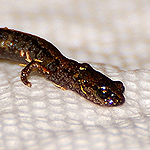
California Slender Salamander (Batrachoseps attenuatus)
I wasn’t intending on posting another fauna piece so soon, but a few nights ago I met someone new on the property. Well, new to me. It was just dark, and I went to lock our hens up for the night. I entered the chicken run where the hens were still milling about, and noticed what I thought was a small dead worm on the ground by the run door. I presumed this was another unfortunate victim that had erroneously wandered into the hen house, and chickens are by nature rather curious creatures.
I was wearing my headlamp as there is no light in the run at night. As I looked at this ‘worm’ more closely, I realized it had legs, they were tiny, but definitely legs! Hmmm…that ruled out the worm theory. Of course, the light from my headlamp immediately drew the hen’s attention toward this small creature, upside down in the run (which is important, I’ll come back to that in a moment), and one hen suddenly charged toward it. Fortunately I had a little grain with me, the chicken equivalent to chocolate or cheesecake, and I managed to successfully divert her attention just long enough to scoop up this as yet unidentified tasty morsel, and set it outside the run door.
I secured the hens in the coop, and turned my attention back to this worm-like creature to see if it was even alive. I watched for a while, and waited, until finally…it moved! It wasn’t moving much, no doubt terrified after being confronted by a gang of godzilla-like hens, and one large king-kong like hominid. At least it was alive, but was it hurt? It was too dark to see if the hens had done any permanent damage to their tiny intruder, so I carefully picked it up, and carried it into the kitchen.
At first, there was so much dirt, bits of grain, feed, and even a small feather stuck to it, it was difficult to see what I was looking at. It lacked scales, so I was fairly certain that it was a salamander of some sort, but it was sooooo small, and certainly not one of the coast newts that we commonly see here, I had no idea who it was. Not wanting to make matters worse, and risk it drying out, I quickly set it on a moistened paper towel, and very gently removed some of the chunkier debris stuck to it with a wet Q-tip. Now that I’d determined it was actually alive, I just wanted to be sure it had no signifiant injuries before finding it a more suitable place to roam outside other than the chicken run!
I took a couple of quick photographs before turning our tiny visitor loose in a secluded damp wooded area near the house, and then using the photos as a guide, I did a quick skim through the California Herps website, which gave me the answer I was looking for. Our tiny visitor was a California Slender Salamander (Batrachoseps attenuatus). Barely 3/4 of an inch from its nose to its back legs, and perhaps no more than 3 1/2 inches long in total, possibly a juvenile. I couldn’t believe I’d never seen one here before. Although in my own defense, they are very small.
These salamanders are native to California, and only found along the Pacific coast of North America. Their coloration is usually dark gray, brown or black above, and they may show a dorsal stripe that can be reddish brown, tan, or yellow. Their tails, like lizards, are very fragile, and can become detached, but when intact, their tail is longer than the head and body.
California slender salamanders, like many salamander species, are lungless, and respire primarily through their skin. They reportedly have 4 toes on the front and hind feet, but to be honest, the legs were so impossibly small that I could barely even see toes, let alone count them! I didn’t have a macro lens on this camera, and this salamander’s small size made it nearly impossible to focus well enough to see very much detail. I did learn that they have between 20-21 costal grooves, lending them a segmented worm-like appearance, hence my initial impression that it might have been a worm.
Like other salamanders they are usually found in damp places, under logs, bark, leaf litter, stumps, and debris, which is a good description of most of our property. They prey primarily on mites, small beetles, termites, spiders and snails. In the dry season they’ve been known to borrow subterranean burrows where the environment is cooler and more moist…perhaps our gophers are good for something after all!
These diminutive salamanders do have predators here on the farm, other than our buff orpington hens that is. Santa Cruz gartersnakes, which are in abundance here, are known to prey on them, as well as scrub jays. Ring-necked snakes are also suspected of predating on these salamanders, and we have quite a few of those here, often spotted out near the orchard slope.
That being said, these salamanders are not necessarily defenseless. Apparently California slender salamanders may engage in a flipping behavior when threatened, where they coil and uncoil rapidly. This flipping behavior can propel an individual salamander 10–20 cm where it may then remain motionless. When I first encountered this salamander it was upside down, and rather dead-looking. Another defense mechanism reported by Steven Arnold in 1982 during a laboratory staged encounter between a California slender salamander and a garter snake, the salamander prevented the snake from eating it by looping its tail around the snake’s head forming a knot. Adhesive skin secretions were then released by the salamander causing the snake’s jaw to become glued shut, and it remained that way for at least 48 hours after the encounter! Quite remarkable for a creature the size of an earthworm.
Now that we know these salamanders are found here, we’ll have to keep an eye out for them in the future. We seem to be toward the southern end of their habitat range here, which runs from Monterey county north to extreme southwestern Oregon. Further inland, they depend heavily on riparian oak woodland, much of which has disappeared in recent years, and efforts are underway in California to protect this species. In the meantime, hopefully this salamander has learned that chicken coops are NOT a sensible place to roam.

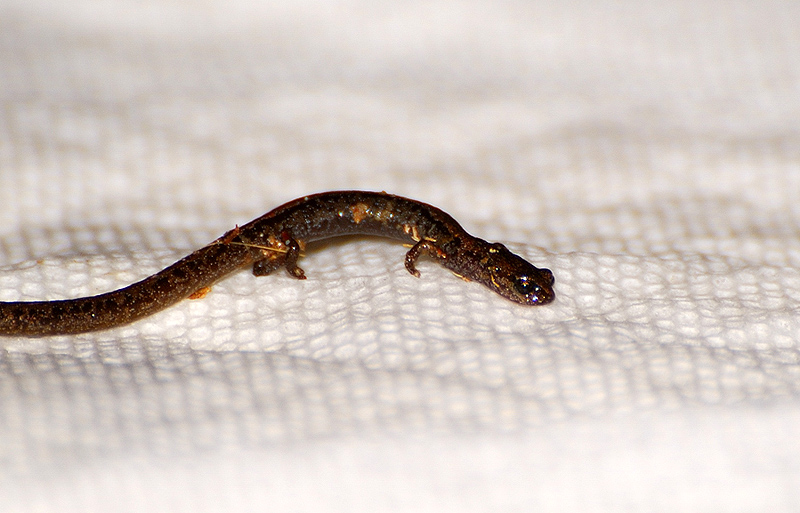
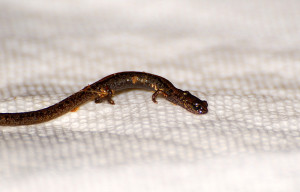
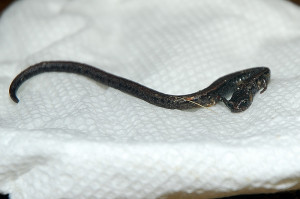
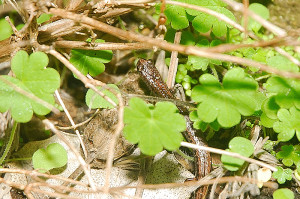







Great post. The first time we found one in our yard I also thought it was a worm till my housemate pointed out the very tiny little legs. They eat all sorts of nasties in the garden so we are glad to have them.